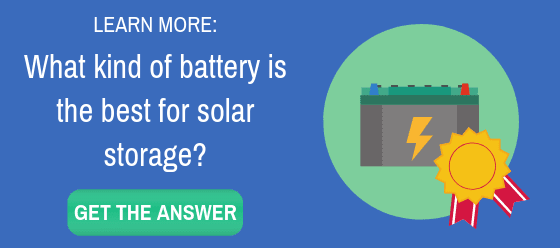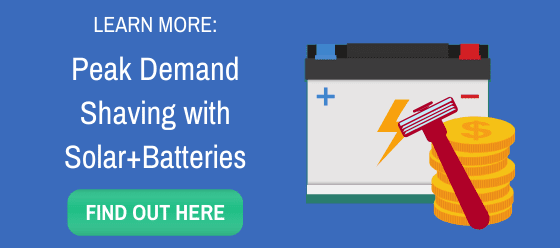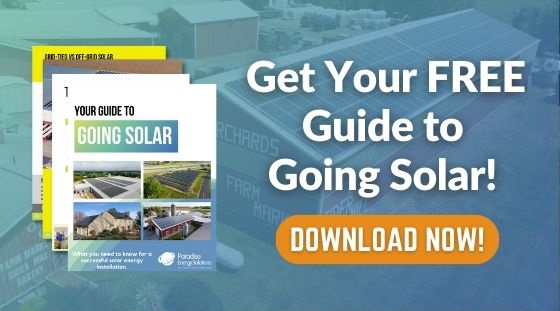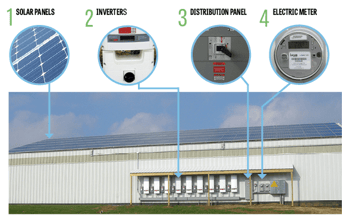Off-Grid vs On-Grid (Grid Tied) Solar Systems | Pros, Cons & More
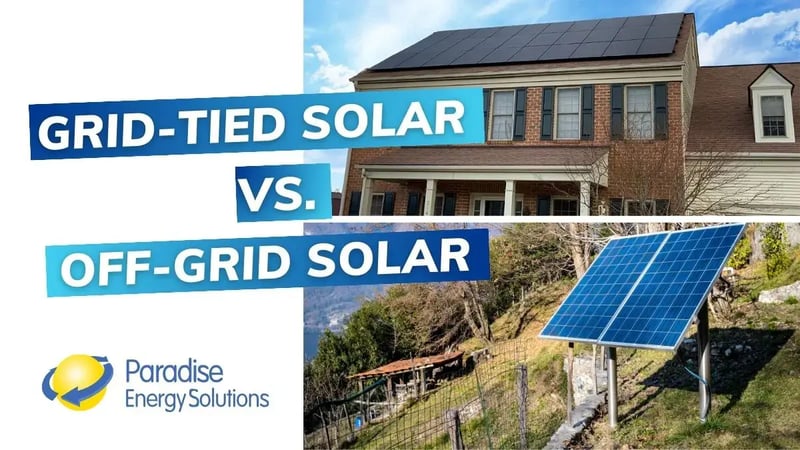
Table of Contents
When purchasing a solar system, you have two main options to consider: grid-tied or on-grid vs. off-grid solar systems. As the name implies, grid-tied solar means the solar system is connected to the electrical grid, and off-grid solar means the solar system is not connected to the grid.
In order to pick the right type of system, it’s important to list the goals you’re hoping to achieve by adding solar energy. Here at Paradise Energy Solutions, our primary focus is grid-tied solar systems, but we realize it’s important to consider the advantages and disadvantages of both grid-tied solar and off-grid solar, so you can identify the system that best meets your goals.
What Is Off-Grid and Grid-Tied Solar Energy?
An off-grid solar energy system is not connected to the utility grid, whereas a grid-tied (aka on-grid) solar energy system is connected to the utility grid. Whether off-grid or on-grid system will determine your access to electricity, what equipment is needed for excess production, what happens when the grid goes down, and how you’re billed for electricity.

Grid-tied Solar Systems
What is an On-Grid Solar System?
A grid-tied solar system is connected to the electrical grid and, unless special equipment is installed, requires the grid to be running for the solar system to produce energy. This type of system integrates seamlessly with the local utility grid, allowing homeowners and businesses to use solar power during the day and draw electricity from the grid when the solar panels aren't generating enough energy, such as at night or on cloudy days.
Advantages of a Grid-Tied Solar System
- Grid-tied systems tend to be the less expensive option due to not needing batteries and other equipment
- This type of system is great for those who don’t have the room or financing to install a solar system big enough to cover 100% of their energy usage. You can continue to pull electricity from the grid if needed
- Net Metering allows the electricity generated by a solar system to offset the electricity used from the grid during the night or on cloudy days
- The grid becomes your cost-effective, reliable storage solution
- In some regions, Solar Renewable Energy Credits (SRECs) allow owners of a grid-tied system to receive extra income by selling the SRECs their system produces
Disadvantages of a Grid-Tied Solar System
- If the grid goes down, your system will shut off, leaving you without power. This is required to prevent energy from backfeeding into the grid to keep utility workers safe. Your grid-tied system will automatically shut off when the grid goes down and will also automatically turn back on when power is restored
- You’re not completely independent from the grid
Off-Grid Solar Systems
What Is an Off-Grid Solar System?
An off-grid solar system operates independently from the electrical grid, making it a self-sustaining power source. These systems are designed to generate and store enough energy to meet all of a household's power needs without any reliance on off-site power sources.
Many people like the idea of installing an off-grid solar system because of the independence and stability the solar system will bring to their lives. However, this is only achievable with the appropriate equipment. To achieve this, off-grid systems require a combination of solar panels, a battery storage system, charge controllers, and an inverter. All of the equipment needed to truly provide an off-grid whole-home system is costly.
The solar panels capture sunlight and convert it into electricity, which is then stored in the batteries for use when the sun isn't shining. The charge controller regulates the energy flow, ensuring the batteries are charged efficiently and safely. The inverter converts the stored DC electricity into AC electricity, which can be used to power typical household appliances and devices.
While the independence offered by off-grid systems is appealing, it necessitates careful planning and investment in robust storage solutions to ensure a continuous and reliable power supply. This setup is particularly popular in remote areas where access to the electrical grid is limited or non-existent, but it also appeals to those who prioritize energy self-sufficiency and resilience.
Advantages of an Off-Grid Solar System
- Completely independent from the grid
- A great solution for remote locations and underdeveloped communities
Disadvantages of an Off-Grid Solar System
- They are more costly
- Batteries are required to deliver electricity consistently throughout the day and night
- It could require a lifestyle change to reduce energy consumption
- Surplus energy production could go to waste
- Cannot rely on the grid at night or on cloudy days
- Batteries require maintenance, have a relatively short lifespan, and degrade rapidly
The Differences Between Off-Grid and On-Grid Solar Energy Systems
Difference #1: Your Access to Electricity
Electricity Access with Off-Grid Solar
What is meant by off-grid solar systems? With an off-grid solar system, you’re completely reliant on the sun and energy stored in batteries to power your home or business.
If you opt for a solar system that is not tied to the electric grid and you do not have a generator, you will only have electricity at two points:
- When the sun is shining, and your solar system is producing electricity.
- When you’re pulling electricity previously generated by your solar system from a solar storage device, like batteries.
If you do not have batteries or a means to store your energy, you will have less or no electricity when it’s cloudy and no electricity at night.
With an off-grid system, you will not have access to extra electricity if you need it. What you are producing and what you have stored is all that’s there to power your equipment.
Electricity Access with On-Grid Solar
If you decide to install an on-grid solar system, you will always have access to electricity (unless the grid goes down), whether or not your solar system is producing, or if you have batteries.
If your system is not producing any electricity or not producing enough electricity to power the devices, lights, machines, etc., that you’re using, you can pull energy from the utility grid to supplement it. This ensures you always have enough electricity for what you need.
Difference #2: What Happens to Excess Production
Excess Production with Off-Grid Solar
Depending on the size of the system you install, how much electricity you use, and when you use that electricity, there will likely be times when your system is producing more electricity than you’re using. What happens to this excess energy depends on the equipment you install.
Most off-grid solar systems are designed to produce a certain amount of “extra” electricity in the daytime, which is sent to batteries for storage. The energy stored in those batteries can then be accessed when the system is not producing, like at night or during cloudy weather.
Depending on your energy goals, systems can be sized to produce enough excess electricity in the daytime to cover your entire energy usage around the clock.
However, despite even the best and most accurate estimates, the weather is unpredictable. If you experience abnormally cloudy weather several days in a row, your system may not be able to produce enough electricity to charge the batteries and fulfill all your needs.
While having extra batteries offers peace of mind and can provide a bank of stored electricity just in case this happens, they’re also expensive. Purchasing more batteries than you need may be cost-prohibitive, depending on your budget.
Excess Production with On-Grid Solar
Just like off-grid solar systems, many who choose to install an on-grid solar system want to cover 100% or nearly 100% of their energy usage. This can be achieved with on-grid systems as well.
Depending on the time of day you use electricity, your solar system can produce excess energy. Instead of sending it to batteries as you would in an off-grid system, you can send it to the grid, and you will be compensated for that electricity.
Many in the United States will be compensated through something called net metering. Net metering is when the utility company compensates or credits your account for electricity generated by your solar system and sent to the grid. Then, whenever you need to draw energy off the grid, you’ll be drawing on those credits to get your electricity without racking up charges on your electricity bill.
39 states currently have mandatory net metering rules. Eleven states are either transitioning or are currently implementing compensation methods other than net metering (like the Value Stack in New York).
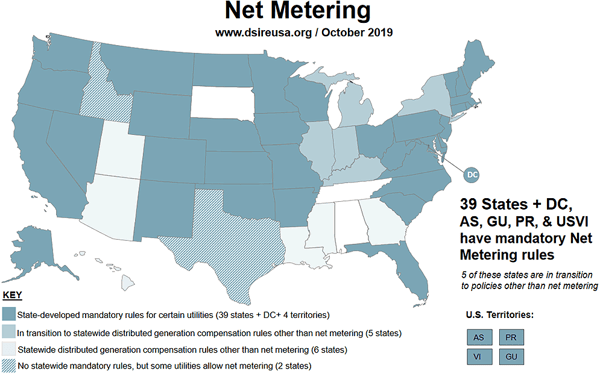 Map from www.eenews.net via https://www.dsireusa.org/
Map from www.eenews.net via https://www.dsireusa.org/
Grid-connected solar power has a distinct advantage over off-grid systems because net metering and other compensation methods from utility companies offer what is essentially free storage.
Difference #3: What Happens When the Grid Goes Down
Power Outages with Off-Grid Systems
Your solar system is working independently from the power grid. If there’s a bad storm or event that knocks out the power, your solar system can continue operating. You won’t notice changes in your service or access to electricity.
Power Outages with Grid-Tied Systems
By connecting to the grid, you get access to electricity whenever you need it. However, you’re also subject to some rules. If you have a grid-tied solar system and the grid goes down, you will not have electricity unless you opt for a grid-tied solar system with battery backup.
Why is this? The Underwriters Laboratories (UL 1741) requires the shutdown of solar systems when the grid goes down. This is for the safety of utility workers who are fixing the power lines.
While this is a disadvantage of grid-tied systems over off-grid systems, if keeping things up and running during a power outage is important to you, then you may be interested in adding batteries to your grid-tied system.
Difference #4: How You’re Billed for Electricity
Electricity Bills with an Off-Grid System
If your PV system is not tied to a grid, you won’t receive an electric bill at all. However, even with no electric bill, off-grid systems are often more expensive because of the additional equipment, like batteries, that are needed to make it viable.
Electricity Bills with a Grid-Tied System
If you opt for a grid-tied system, you may still see minimal charges on your electricity bill, even if your solar system provides 100% of your electricity.
One type of charge you may continue to see is the service fee or delivery charge. This is the cost levied on customers for connecting their home or business to the grid. For many utilities, this fee is a flat rate that is not impacted by how much electricity you use.
Another type of charge you can see is demand charges. Demand charges are typically levied on commercial properties and are the increased electric rates you pay for the power you use during a peak demand period. The peak demand period is typically the 15-minute period in which your business uses the most electricity.
Because using a large amount of electricity at one time puts a strain on the grid, the utility will charge a higher rate for the electricity used during that period.
If your peak demand period is during the day, you may be able to reduce it with solar, as energy produced by your system will compensate for some of the energy you use from the grid. If you pay very high demand charges, you may also want to look into peak demand shaving with solar and batteries.
Depending on how much energy your solar system produces and how much energy your home or business uses, you may see an electric charge for the electricity you pulled off the grid and used that wasn’t covered by your net metering credit.
Hybrid Solar Energy Systems
A hybrid solar energy system is tied to the grid but also has a battery bank to store unused electricity. Though more expensive due to the added cost of batteries, hybrid systems allow their owners to keep the lights on when the grid goes down and can even help reduce demand charges for businesses.
If you’re interested in learning more about a hybrid solar energy system, check out our blog: How to Size Batteries for a Solar System.
 There are two ways for grid-tied solar systems to be connected to batteries: DC Coupling and AC Coupling.
There are two ways for grid-tied solar systems to be connected to batteries: DC Coupling and AC Coupling.
While there are distinct differences between off-grid and grid-tied solar systems, the one that is best for you is dependent on your situation. Off-grid systems allow for complete freedom from the utility, but they’re often more expensive. Grid-tied systems marry significant electricity savings with grid-backed dependence, so you’ll never have to worry about not having the electricity needed to power your house or business.
Frequently Asked Questions (FAQs)
How much do off-grid and grid-tied solar systems cost?
The cost of off-grid and grid-tied solar systems can vary widely depending on several factors, including the size of the system, the quality of the components, and the complexity of the installation. On average, an off-grid solar system with batteries can cost upwards of $75,000. A residential grid-tied system typically ranges from $25,000 to $55,000; batteries will add another $20,000 or more to the cost of a grid-tied system. It's important to note that these are rough estimates, and the actual cost can vary based on individual circumstances.
To help gain a better understanding of the cost of a solar system, check out our solar savings calculator. If you’re curious about battery backups, use our battery calculator to determine the backup power you will require.
Does grid-tied solar work when the power is out?
In most cases, grid-tied solar systems are designed to shut off automatically when the power goes out. This is a safety feature intended to prevent electricity from being fed back into the grid and potentially harming utility workers who may be working to restore power. However, some grid-tied systems are equipped with battery backup systems that allow them to continue providing power to the home during an outage. Additionally, there are newer inverters, such as the Enphase IQ8, that allow the use of solar energy during an outage. The IQ8 and additional required components are more expensive but offer the added benefit of backup power in case of emergencies- at least while the sun is shining.



